- You have no items in your shopping cart
- Continue Shopping
Marketing 101 – The Ultimate Guide to Marketing Strategy
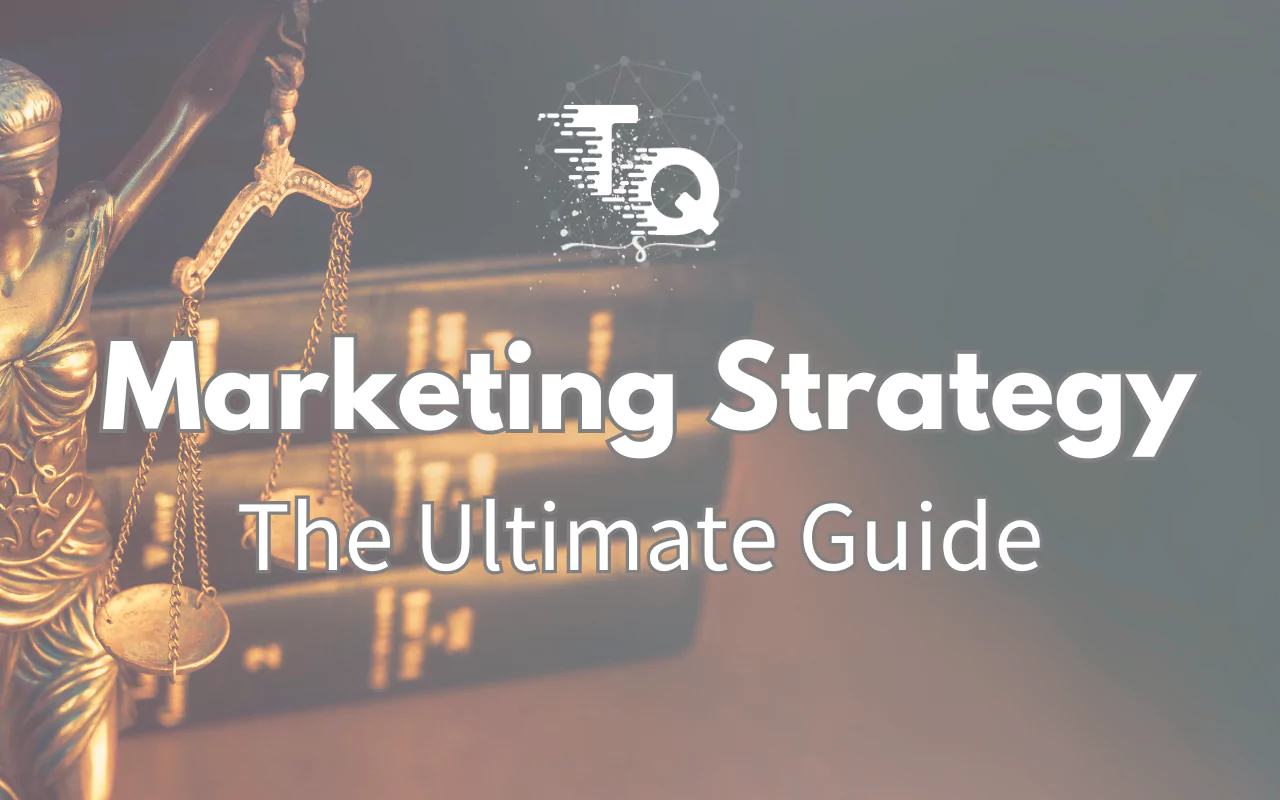
Introduction
Welcome to “Marketing 101 – The Ultimate Guide to Marketing Strategy,” a comprehensive resource designed to navigate the global competitive landscape of business. With insights drawn from extensive experience in digital marketing and SEO, this guide serves as a strategic blueprint for startups, traditional businesses, and established enterprises worldwide. It offers actionable strategies and expert advice to help you make informed decisions, engage customers, and drive growth no matter where your business calls home.1. Core Marketing Strategy Elements
Product Strategy: The Blueprint of Success
The product is the cornerstone of any marketing strategy. Strategic product management involves understanding market needs, leveraging competitive analysis, and ensuring that the product life cycle aligns with market dynamics. It's about creating a product that not only meets customer needs but does so in a way that is distinct from competitors.Pricing as a Strategic Tool
Pricing isn't just about covering costs and earning a profit; it's a strategic lever that affects market positioning and customer perception. Strategic pricing involves understanding the value customers place on your product and using pricing models to capture that value, influence market demand, and drive business objectives.Promotion: The Strategic Communication Mix
Strategic promotion goes beyond mere advertising; it's about selecting the right mix of communication methods to reach and influence your target audience effectively. It involves crafting messages that resonate with your audience's values and needs, using data-driven insights to tailor your approach.Place: Strategic Channel Management
The strategic choice of distribution channels directly impacts market reach and customer satisfaction. It's about making your product available where your customers are most likely to buy it, whether it's online, in-store, or through a third-party retailer, ensuring convenience and accessibility.
Marketing strategy is one of the most important aspect in business essentials. You may refer The Ultimate Guide to Business Essentials for details.
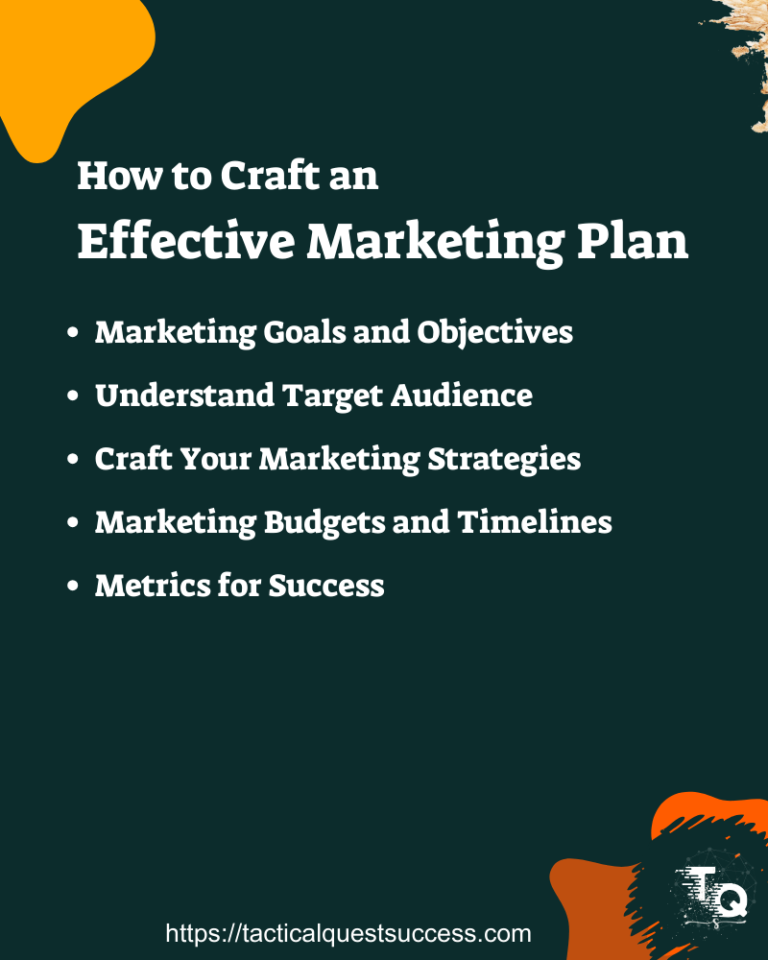
2. Creating a Marketing Plan
A marketing plan is a strategic document that outlines a company's marketing efforts to achieve specific business goals. It is a detailed roadmap that includes the following elements:
- Goals and Objectives: These are the fundamental "what" and "why" of your marketing efforts. Clear goals and objectives provide direction and a benchmark for success.
- Target Audience: Knowing "who" you are marketing to is crucial. A deep understanding of your audience ensures that strategies are crafted to meet their needs and preferences.
- Marketing Strategies: This section details the "how" of reaching your goals. It includes the tactics and channels you plan to use.
- Budgets and Timelines: A practical marketing plan is grounded in reality, with clear budgets and timelines that ensure strategies are financially and logistically feasible.
- Metrics for Success: These are the "measuring sticks" for evaluating the effectiveness of marketing activities.
Key Takeaways for a Marketing Plan
- Clarity: A successful marketing plan starts with a clear vision of desired outcomes.
- Consistency: Consistency in messaging reinforces brand recognition and customer trust.
- Flexibility: The best marketing plans are those that can adapt based on performance data.

3 Conducting Market Research with a Strategic Purpose
Market research is not just about gathering data; it’s about extracting strategic insights that will inform your business decisions. It involves defining clear objectives, employing both primary and secondary research methodologies, and using the findings to shape your marketing strategy. The process includes:- Defining Research Objectives: Clearly articulate what you aim to discover through your research.
- Designing the Research: Choose the right mix of qualitative and quantitative methods and tools.
- Data Collection: Gather information from the market or existing sources to form a comprehensive view.
- Data Analysis: Interpret the data to gain insights into customer preferences and market conditions.
- Reporting Findings: Present the data in a format that highlights key findings and strategic insights.
- Making Informed Decisions: Apply the insights to refine your marketing strategy and tactical plans.
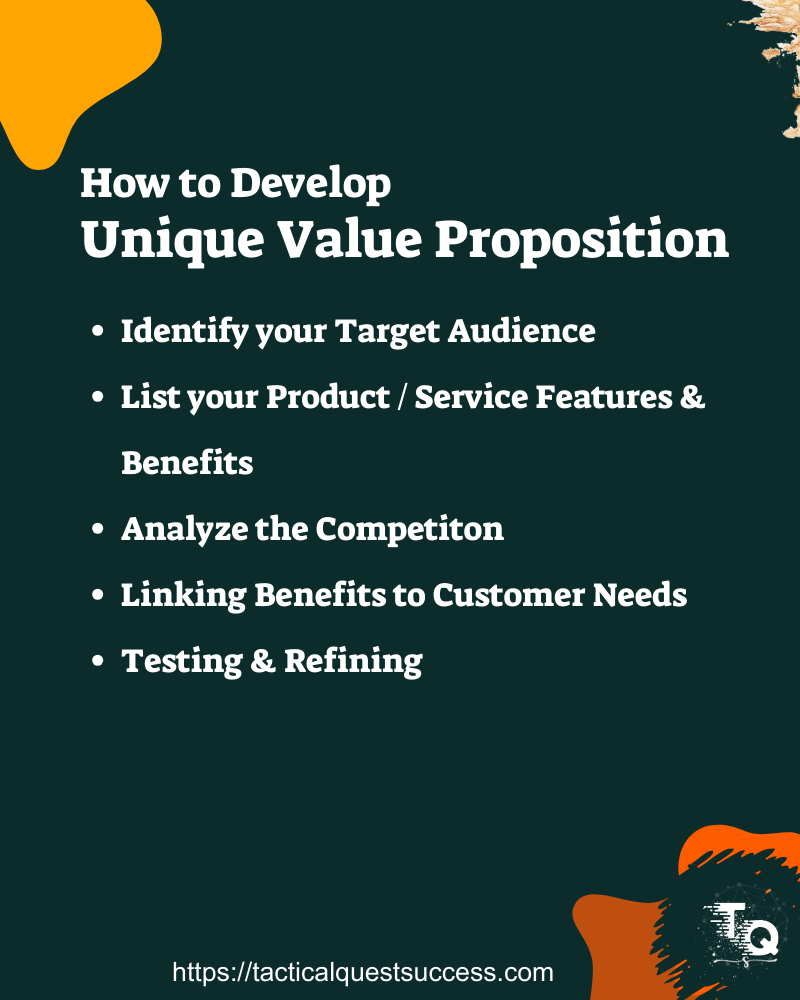
4 Crafting and Refining a Unique Value Proposition (UVP) and Unique Selling Proposition (USP)
Unique Value Proposition (UVP)
Your UVP is the strategic articulation of the unique benefits your product or service provides. It’s about distilling your competitive advantage into a clear, concise, and compelling message that differentiates your brand in the marketplace. The steps to develop a UVP include:- Identifying Your Target Audience: Understand who your customers are and what they need.
- Listing Your Product/Service Features and Benefits: Clearly define what you offer and why it’s valuable.
- Analyzing the Competition: Know your competitors’ offerings and identify what sets you apart.
- Linking Benefits to Customer Needs: Connect the dots between your benefits and your customers’ pain points.
- Testing and Refining: Validate your UVP with real customers and refine it based on feedback.
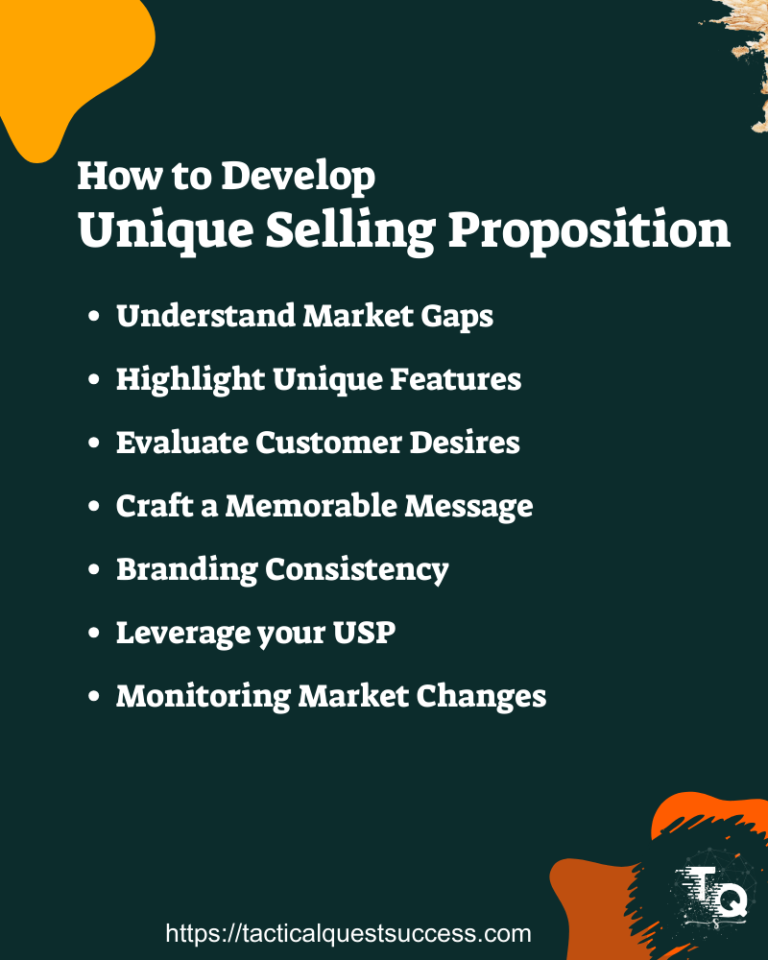
Unique Selling Proposition (USP)
Your USP is the defining factor or feature of your product or service that sets it apart from competitors in the market. It’s a specific position that your business takes to be memorable and desirable to your target audience, often encapsulated in a slogan or tagline. Developing a USP involves:- Understanding Market Gaps: Research the current market to find unmet needs or areas where competitors are not focusing.
- Highlighting Unique Features: Identify features of your product or service that are unique to your business and not offered by others.
- Evaluating Customer Desires: Consider what aspects of your product or service are most appealing to your customers and why they choose you over competitors.
- Crafting a Memorable Message: Develop a succinct and memorable message that encapsulates your unique features and customer benefits.
- Consistency Across Branding: Ensure that your USP is consistently represented across all branding and marketing materials.
- Leveraging Your USP: Use your USP to guide marketing campaigns, product development, and customer service to reinforce your market position.
- Monitoring Market Changes: Keep an eye on market trends and be ready to adjust your USP to stay relevant and competitive.
Choosing the Right Marketing Channels Based on Strategic Goals
- Social Media: Facebook, Instagram, LinkedIn, Twitter, Pinterest, TikTok
- Content Marketing: Blogs, eBooks, Whitepapers, Infographics, Videos
- Email Marketing: Newsletters, Promotional Campaigns, Automated Sequences
- SEO: Organic Search, Keyword Optimization, Link Building
- PPC Advertising: Google Ads, Bing Ads, Social Media Ads
- Affiliate Marketing: Partnership Programs, Affiliate Networks
- Influencer Marketing: Collaborations with Influencers, Brand Ambassadors
- Public Relations: Press Releases, Media Relations, Event Marketing
- Offline Advertising: TV, Radio, Print Ads, Billboards
- Direct Marketing: Postal Mailers, Catalogs, Telemarketing
- Event Marketing: Webinars, Conferences, Trade Shows

The process of selecting the right marketing channels includes:
- Aligning with Your Audience: Choose channels where your target audience is most active.
- Considering Your Budget: Evaluate the cost-effectiveness of each channel.
- Matching Your Content: Ensure your content fits the channel’s format and audience preferences.
- Testing and Measuring: Experiment with different channels and measure their performance.
- Adapting and Optimizing: Use performance data to refine your channel strategy.
Digital vs. Traditional Marketing
The debate between digital and traditional marketing is ongoing, but the advantages of digital marketing are clear:
- Reach: Digital marketing has the potential to reach a vast, global audience instantly.
- Cost: It is often more cost-effective, allowing for a more diverse and extensive marketing mix.
- Analytics: The analytics provided by digital marketing are invaluable for refining marketing strategies.
Key Takeaways for Digital vs. Traditional Marketing
- Reach: Utilize digital marketing for its expansive reach.
- Cost: Leverage the cost-efficiency of digital methods to maximize your marketing budget.
- Analytics: Use the rich data from digital marketing to make informed strategic decisions.
I strongly suggest you grab this Ultimate Marketing Guide Handbook to boost your marketing effort.
Embracing the Latest Marketing Trends
Staying abreast of the latest marketing trends can provide a competitive edge. Current trends include:- Personalization: Modern consumers expect marketing to be tailored to their individual needs.
- Technology: AI and machine learning are revolutionizing how we analyze data and automate marketing.
- Content Marketing: Providing valuable content helps build relationships and trust with your audience.
- Personalization: Use data analytics to personalize marketing at scale.
- Technology: Implement technology to create more efficient and targeted marketing campaigns.
- Content Marketing: Focus on delivering quality content that educates and engages your audience.
Localizing Marketing for the Malaysian Market
Localizing marketing strategies for the Malaysian market means understanding and integrating into the local cultural and consumer landscape:- Cultural Sensitivity: Marketing campaigns must be sensitive to local customs and values.
- Local SEO: Optimize for local search trends to capture the Malaysian market effectively.
- Community Engagement: Engage with local communities through events and forums to build brand presence.
- Cultural Sensitivity: Adapt marketing strategies to align with Malaysian cultural nuances.
- Local SEO: Focus on local SEO strategies to improve visibility in Malaysian search results.
- Community Engagement: Foster strong community ties for brand loyalty and advocacy.
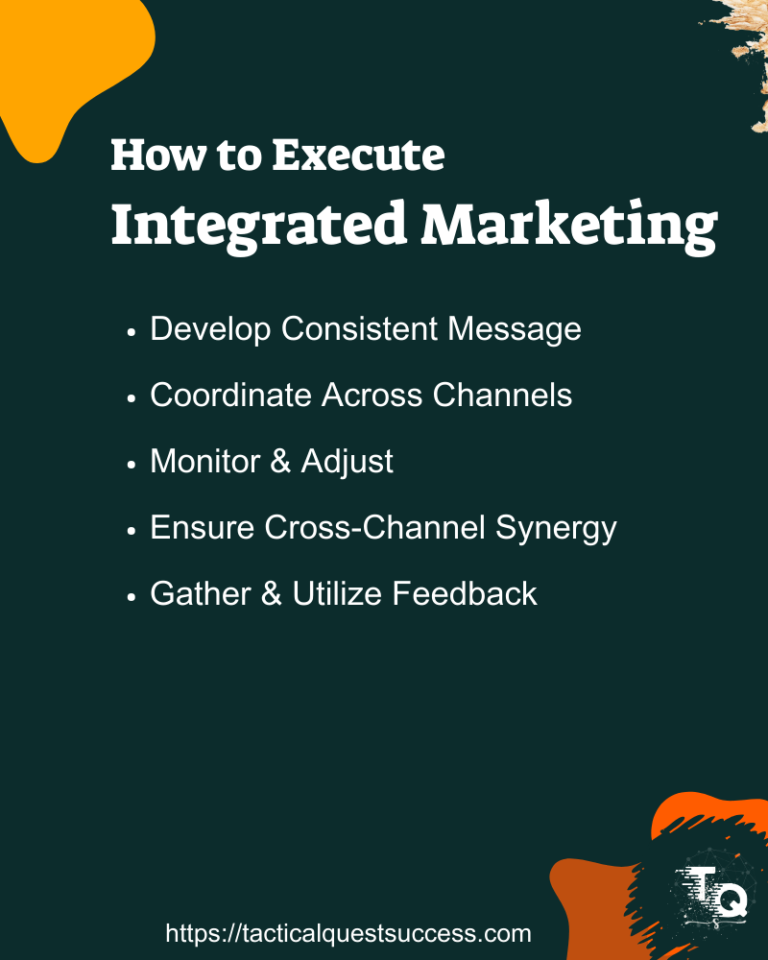
6 Integrated Marketing Communication as a Strategic Approach
Integrated marketing communication ensures that all channels work together in harmony, amplifying the strategic messaging and creating a unified brand experience for the customer. It’s a strategic orchestration of various marketing activities to build a consistent brand voice and message across all touchpoints. The steps for integrated marketing execution include:- Developing a Consistent Message: Craft a core message that aligns with your brand and resonates across all channels.
- Coordinating Across Channels: Plan campaigns that use multiple channels in a complementary way.
- Monitoring and Adjusting in Real-Time: Keep an eye on campaign performance across channels and adjust as needed.
- Ensuring Cross-Channel Synergy: Make sure all channels support and enhance each other.
- Gathering and Utilizing Feedback: Use customer feedback to improve future integrated marketing efforts. Continuing from where the previous message left off, here’s the integration of the provided sections into the long article:
Social Media Marketing Best Practices
Social media marketing is a dynamic and interactive way to connect with customers:- Platform Selection: Choose the right platforms based on where your target audience is most active.
- Content Strategy: Create content that leverages each platform’s unique strengths and audience preferences.
- Engagement: Regular interaction with your audience can transform followers into brand advocates.
- Platform Selection: Be strategic about which social media platforms you use.
- Content Strategy: Plan your content to align with both the platform and your marketing goals.
- Engagement: Engage with your audience to build a community around your brand.
7 Strategic Implications of Brand Awareness and Customer Engagement
Brand awareness and customer engagement are not just goals; they are strategic imperatives that drive customer loyalty and sales. A strategy that elevates brand visibility and actively engages customers can transform the market’s response to your product or service. Strategies for brand awareness include:- Leveraging Social Media: Use targeted social media campaigns to reach a broad audience.
- Content Marketing: Create valuable content that establishes your brand as a thought leader.
- SEO: Optimize for search engines to increase your brand’s online visibility.
- Collaborating with Influencers: Partner with influencers to tap into their follower base.
- Community Engagement: Participate in or sponsor local events and charities.
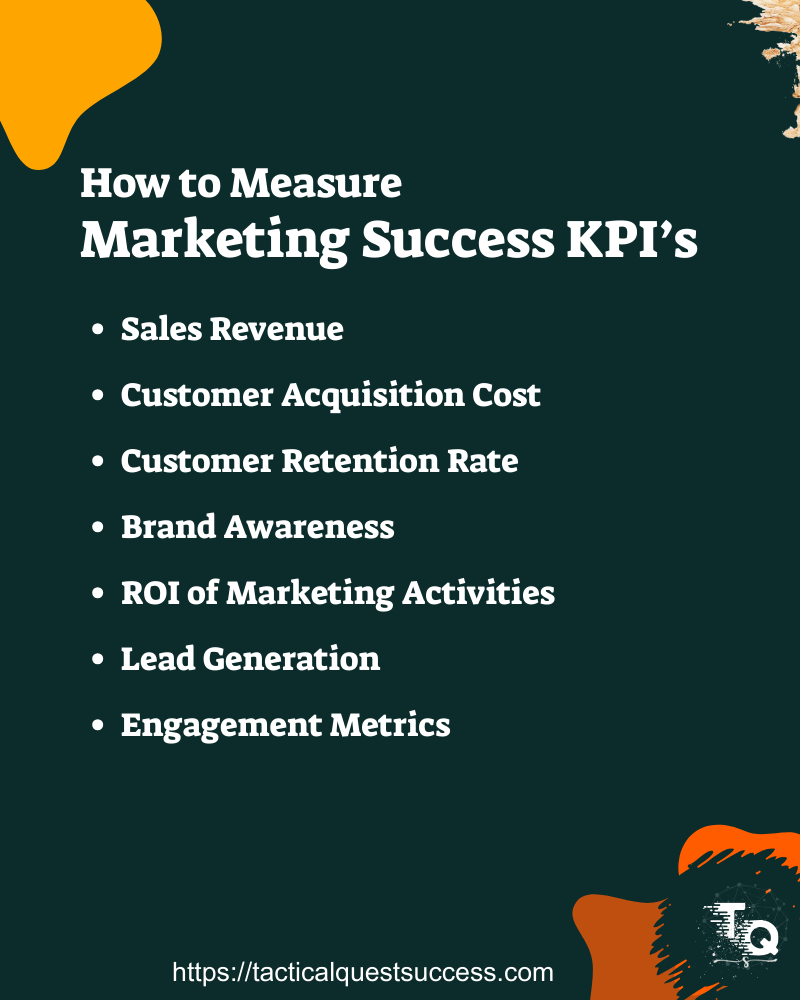
8 Measuring the Success of a Marketing Strategy
The success of a marketing strategy can be measured using various key performance indicators (KPIs). These KPIs provide insight into the effectiveness of marketing efforts and guide future strategy adjustments. The KPIs for marketing success include:- Sales Revenue: Track sales growth directly attributed to marketing efforts.
- Customer Acquisition Cost: Measure the cost to acquire a new customer through marketing.
- Customer Retention Rate: Evaluate how well your marketing keeps customers over time.
- Brand Awareness: Assess how well potential customers recognize and recall your brand.
- ROI of Marketing Activities: Calculate the return on investment for each marketing channel.
- Lead Generation: Monitor the number of new leads generated by marketing campaigns.
- Engagement Metrics: Analyse engagement levels, including likes, shares, and comments.
Continuous Learning and Innovation in Marketing
Stay ahead in the dynamic field of marketing by:- Keeping Up with Marketing Trends: The marketing world is constantly evolving; staying updated with the latest trends is essential.
- Being Adaptable in Strategy: Flexibility in marketing strategies is crucial. Be prepared to adapt your approach to align with emerging market demands and consumer behaviours.
Resources for Advancing Your Marketing Knowledge
To enhance your expertise in marketing, consider these valuable resources:- Educational Websites: Visit platforms like MarketingProfs for comprehensive articles and insights on various marketing topics.
- Online Marketing Courses: Engage in structured courses to deepen your understanding of marketing concepts and strategies.
- Marketing Books and eBooks: Tactical Quest Success offers a diverse selection of eBooks focused on marketing strategies and digital marketing trends.
- Workshops and Seminars on Marketing: These provide practical, hands-on experience and up-to-date knowledge in the field of marketing.
Enhance your marketing prowess and stay ahead in the dynamic world of marketing with the Marketing 101 Handbook – Your Ultimate Marketing Guide!
Conclusion
At Tactical Quest Success, we understand the importance of global marketing strategies that are adaptable to diverse markets, including the dynamic regions of Malaysia and Southeast Asia. Our e-books provide a solid foundation of universal principles and strategies, tailored to meet the unique needs of localization and customization.
As you embark on your international marketing journey, it's essential to remain attuned to the distinct preferences and opportunities of your global clientele. By thoughtfully implementing these strategies, you'll not only witness your marketing endeavors flourish but also pave the way for success that transcends geographical and cultural barriers. Let's harness the power of strategic marketing to achieve triumphs in the global arena.
Click here to browse through our vast collection of eBooks.
Summary
| Section | Key Points |
|---|---|
| Core Marketing Strategy Elements | – Product strategy as market alignment and differentiation – Pricing as a strategic tool for positioning and value capture – Promotion through a mix of communication methods – Place as strategic channel management |
| Creating a Marketing Plan | – Set clear goals and objectives – Understand the target audience – Detail marketing strategies and tactics – Define budgets and timelines – Establish metrics for success |
| Conducting Market Research | – Define research objectives – Design research with qualitative and quantitative methods – Collect and analyze data – Report findings to inform strategy |
| Unique Value Proposition (UVP) & Unique Selling Proposition (USP) | – Identify target audience and their needs – List product/service features and benefits – Analyze competition to establish UVP – Link benefits to customer needs – Test and refine UVP – Develop and leverage USP for market positioning |
| Choosing the Right Marketing Channels | – Align channels with audience activity – Consider budget and content match – Test and measure channel performance – Adapt and optimize based on data |
| Integrated Marketing Communication | – Develop a consistent message across channels – Coordinate campaigns for cross-channel synergy – Monitor and adjust strategies in real-time – Utilize feedback for improvement |
| Brand Awareness and Customer Engagement | – Use social media and content marketing for visibility – Optimize SEO for online presence – Collaborate with influencers – Engage with community events |
| Measuring Marketing Success | – Track sales revenue and growth – Calculate customer acquisition cost – Measure customer retention rate – Assess brand awareness levels – Calculate ROI for marketing activities – Monitor lead generation and engagement metrics |
Frequently Asked Questions (FAQs) about Marketing Strategy
Target Audience Identification
Know your customers' demographics and interests.Value Proposition
Clearly define what makes your product or service unique.Marketing Channels
Choose the right platforms (social media, email, etc.) to reach your audience.Content Strategy
Develop engaging and relevant content for your audience.Budget Planning
Allocate resources wisely, balancing cost and potential return.Analysis and Adaptation
Continuously assess performance and adjust your strategy accordingly.
Complementary Role
Digital marketing complements traditional methods by reaching wider and more targeted audiences online.Cost-Effective
Offers cost-effective alternatives to traditional advertising, like social media and SEO.Data-Driven Insights
Provides valuable data for understanding customer behavior and preferences.
Personalization
Tailoring content to individual customer preferences.Influencer Marketing
Collaborating with influencers to reach target audiences.Video Content
Increasing focus on video platforms and video marketing.Sustainability
Highlighting eco-friendly practices and products.AI and Automation
Using AI for personalized marketing and automation of repetitive tasks.
KPIs (Key Performance Indicators)
Track metrics like website traffic, conversion rates, social media engagement, and ROI (Return on Investment).Customer Feedback
Gather and analyze customer feedback and reviews.Sales Data
Monitor sales patterns and growth.
Brand Awareness
Increases visibility and brand recognition.Customer Engagement
Facilitates direct interaction with customers.Targeted Advertising
Allows for highly targeted and cost-effective advertising.Content Distribution
Efficient platform for distributing various types of content.
Focus on Local SEO
Optimize for local search to attract nearby customers.Leverage Social Media
Use platforms your customers frequent to build relationships and brand loyalty.Email Marketing
Develop a strong email list for direct, cost-effective communication.Partnerships and Networking
Collaborate with local businesses and networks for mutual promotion.Customer Referrals
Encourage word-of-mouth through referral programs.
Set Clear Goals
Define what you want to achieve (brand awareness, sales, etc.).Choose the Right Channels
Identify where your target audience spends their time online.Content Planning
Create a content calendar with varied and engaging content.SEO Strategy
Implement SEO practices to improve online visibility.
Click here to learn more on SEO services available.Monitor and Adapt
Regularly review analytics to refine your strategy.
Define Your Goals
Establish what you aim to achieve with social media, such as increasing brand awareness, driving traffic, or generating leads.Understand Your Audience
Identify and understand your target audience's preferences and behaviors on different social media platforms.Select Appropriate Platforms
Choose social media platforms that align with your brand and where your target audience is most active.Create Engaging Content
Develop content that resonates with your audience, encouraging interaction and sharing.Incorporate Social Media in All Campaigns
Ensure social media is a part of all marketing campaigns for a cohesive strategy.Monitor and Analyze Performance
Regularly track your social media metrics to understand the impact and refine your strategy accordingly.
Guerilla Marketing
Implement unconventional, low-cost tactics to capture attention.Influencer Collaborations
Partner with influencers for a wider reach.User-Generated Content
Encourage customers to share their experiences with your product/service.Viral Challenges
Create or participate in social media challenges to gain visibility.Data-Driven Personalization
Use customer data to personalize marketing messages.
Track Expenditure vs. Revenue
Compare the costs of your marketing efforts against the revenue generated.Conversion Rates
Analyze how many leads are converted into customers.Customer Acquisition Cost (CAC)
Calculate how much it costs to acquire a new customer.Lifetime Value (LTV)
Determine the projected revenue a customer will bring over their lifetime.Engagement Metrics
Assess the engagement levels (likes, shares, comments) and their impact on sales.
Integrating SEO into your marketing strategy enhances business growth by
Boosting Organic Reach
Improving search engine rankings to organically reach a wider audience without the constant cost of paid advertising.Enhancing User Experience
SEO not only optimizes for search engines but also focuses on creating a better user experience, which is crucial for keeping visitors engaged on your website.
SEO is essential in a modern marketing strategy for
Long-Term Visibility in Search Engines
Consistently appearing in search results builds long-term brand recognition and credibility, essential in today's digital landscape.Cost-Effective Customer Acquisition
Unlike traditional advertising, SEO targets users who are actively searching for your products or services, leading to more cost-effective customer acquisition.
Professional SEO services can significantly elevate your marketing efforts by
Tailored Keyword Strategies
Developing customized keyword strategies to target your specific audience, enhancing the effectiveness of your overall marketing plan.Data-Driven Insights
Utilizing advanced tools and analytics to continuously refine your SEO tactics, aligning them with your broader marketing objectives.
Explore comprehensive SEO services here.
SEO plays a pivotal role in content marketing by
Optimizing Content for Better Reach
Ensuring that your valuable content is seen by more people by optimizing it for relevant search queries.Driving Targeted Traffic to Content
Attracting the right audience to your content, which is more likely to engage and convert, thereby supporting your overall marketing goals.
Explore more on SEO.

